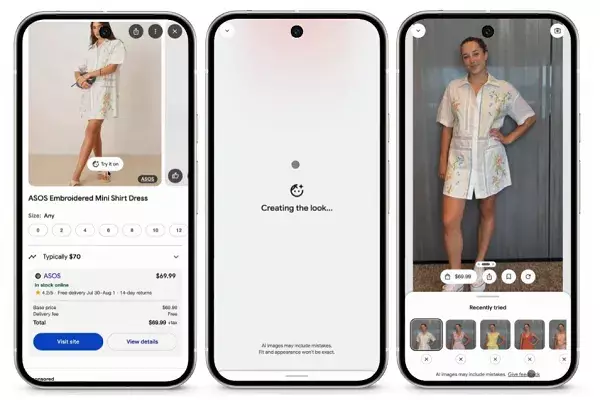Google’s latest advancement in e-commerce signifies a pivotal shift towards truly personalized online shopping experiences. The introduction of AI-powered virtual try-on tools allows consumers to see how clothing items look on them using their own selfies. This feature, initially exclusive to a select group, has now become broadly accessible in the United States, marking a major democratization of advanced retail technology. This innovation blurs the line between in-store shopping and digital convenience, offering consumers a more accurate visualization of their potential purchases from the comfort of their homes.
This move pushes the industry closer to replicating the tactile and visual feedback of physical shopping. Imagine browsing options in your pajamas and instantly seeing yourself in those trendy gingham pants or a sleek jacket—all without stepping into a store. This sense of immediacy and personalization can reduce the hesitation that often accompanies online buying, such as doubts about fit or style. However, the real test lies in the accuracy of these virtual try-ons: how closely do the digital renderings match real-world appearances? If Google’s AI can consistently deliver reliable results, it might revolutionize how we approach fashion e-commerce, making it more intuitive and less full of guesswork.
Yet, despite the promise, there remains room for skepticism. AI-driven try-on relies heavily on the quality of user-uploaded images and the AI’s interpretative abilities. Variability in lighting, camera angles, or body positioning could skew results, leading to potential dissatisfaction. Nonetheless, continuous refinement and user feedback will be crucial in determining whether this technology can become as dependable as trying on clothes in the fitting room.
Empowering Shoppers with Smarter Price Tracking
In a climate where consumers are increasingly price-conscious, Google’s upgraded price tracking features are a significant gift. This enhancement allows users to set specific preferences—size, color, and target price—enabling a more tailored and strategic approach to online shopping. Such precision reduces the frustration of missing out on sales or spending more than intended.
With the Shopping Graph aggregating deals across a vast array of online sellers, consumers can expect timely alerts when price drops align with their set criteria. This kind of proactive shopping intelligence shifts control back into the hands of consumers, encouraging smarter purchasing decisions and maximizing savings. The convenience of monitoring prices across multiple sites with minimal effort transforms what used to be a tedious process into a seamless experience.
However, this feature’s success hinges on the accuracy and timeliness of alerts. If notifications are delayed or imprecise, shoppers might still miss discounts or experience frustration. Furthermore, as e-commerce continues to evolve, competitors will likely introduce similar tools, intensifying the race for more precise, user-friendly price tracking. Google’s initiative here demonstrates its understanding that modern shoppers seek not just variety but also visibility and control over their expenditures.
Unlocking New Discovery Pathways Through AI-Driven Search
Google’s newest AI-powered search and product description tools redefine how we find fashion styles and related products online. Conversational queries, powered by improved natural language understanding, make it easier to articulate what we’re seeking, translating vague descriptions into precise matches. For instance, describing an outfit as “casual, black, and suitable for a weekend outing” now yields insights that align closely with user intent.
This development signifies Google’s recognition that shoppers rarely approach searches with pinpoint accuracy; rather, they seek recommendations based on vague but meaningful preferences. By allowing text-based matching to understand and interpret these nuances, Google intensifies its role as a personalized stylist, guiding users toward perfect purchases that align with their style identity.
Nonetheless, this advancement also presents challenges. The AI must accurately decipher complex descriptions and contextual cues without misinterpretation. Any failure in understanding user intent could lead to irrelevant results, undermining confidence in the system. Still, enhancing AI comprehension capabilities positions Google well ahead in the race to deliver more intuitive, human-like shopping experiences that consider individual tastes and needs.
Anticipating Future Transformations in Digital Retail
Google’s current innovations serve as a glimpse into how AI-driven tools are reshaping e-commerce, blending convenience, personalization, and smarter decision-making. As these features mature, the online shopping landscape could become dramatically more engaging and responsive. Imagine a future where virtual fitting rooms, real-time price alerts, and conversational search queries become standard, creating an ecosystem that truly adapts to each shopper’s desires.
In such a landscape, consumers gain the power to make more informed, confident decisions while retailers can foster deeper customer loyalty through tailored experiences. Yet, these technological advancements also demand critical scrutiny—privacy concerns, AI reliability, and equitable access remain pressing issues that must be addressed. Only through careful balancing can AI truly fulfill its promise of elevating the online shopping journey into an experience that is both innovative and trustworthy.


Leave a Reply